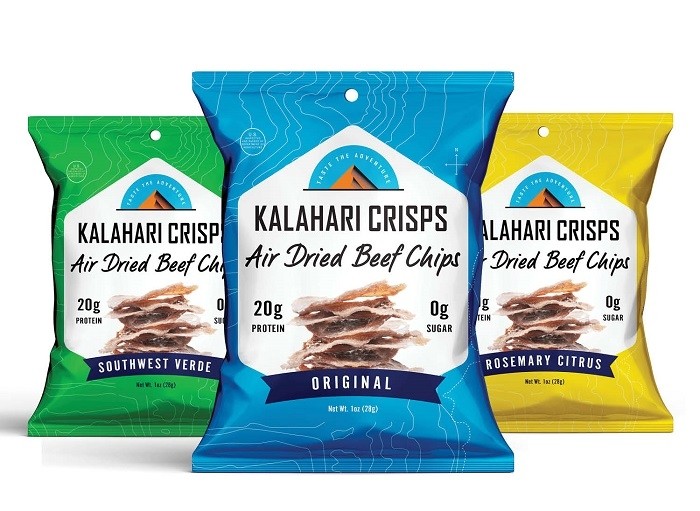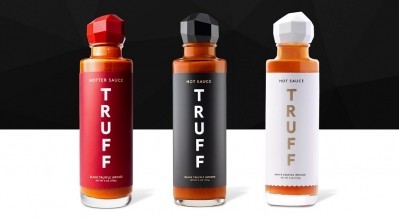Kalahari Snacks helps usher in ‘next evolution’ of meat snacks with new beef crisps

With the crunchy texture of classic plant-based chips, but made from simply spiced top round beef that is thinly sliced, air-dried and roasted, Kalahari Crisps offer a macronutrient profile that consumers don’t need to feel guilty about if they eat an entire bag, said company co-founder Tyler Noyes.
Pointing to the crisps’ 20g of protein and only 100 calories per serving along with zero carbs or sugar, Noyes explained that the new line is the perfect antidote to “mindless munching” – a phenomenon that anecdotally has been on the rise during the coronavirus pandemic among people working and sheltering at home with easy access to their kitchens and fewer options for entertainment.
“We wanted to deliver a Kalahari twist on this by taking the phrase [mindless munching] and turning it on its head with a crunchy meat snack that was meant for mindful munching,” Noyes said.
He explained that while the “super thin” crisps are just as crunchy as traditional chips, they also have a “nice chew to them at the end, after the crunch, which feels really satiating in that it is not quite like a chip that is gone into crumbs in two seconds and you can just wolf down” without thinking.
Beyond the crunch and better-for-you nutrition profile, the crisps also deliver on flavor with three options that “stand out on their own and are differentiated from our biltong flavors,” Noyes said. “We have an original that is sea salt and very traditional basic flavor, and then we were able to think what are some other chip-lover favorites? And we have a phenomenal southwest verde, which is my favorite, and a rosemary citrus.”
Unwilling to compromise on any aspect of the crisps, the company also ensured that they could deliver utility and function, added co-founder Brett Johnston. “A lot of what we looked at when creating biltong was utility and the way it was used in South Africa when you went to the vineyards and had it on a charcuterie board or on a salad. And with the chips we tried to do the same thing and give it that same utility, whether as a mechanism for a dip” or a crunchy solution for a savory craving.
Standing out from the competition
While still novel, the concept of chips made with or from meat isn’t entirely new. However, Noyes said, Kalahari will take the idea to a new level.
As far back as 2015, Meat Chips launched a line of high-protein corn tortilla chips that also contained white chicken meat as a better-for-you alternative to traditional corn chips with 21 grams of protein and between 30-50% fewer calories. A little over a year after launching, the brand posted its last Tweet and the company’s website has since expired.
In 2018, Wilde launched its chicken chips nationwide in Whole Foods and Sprouts touting them as “more than meats the eye” with chicken as the first ingredient followed by tapioca flour, sunflower oil and a combination of spices and various types of sugar depending on the flavor and broth. The brand, which is available in a variety of flavors, also claims on the front of its pack 10 grams of protein per serving.
Other players offering chicken-based chips include Gone Rogue, which offers a significantly higher 18 grams of protein per serving, and has a longer ingredient list that includes sodium erythobate, sodium nitrite, dextrose and others. It also warns on packages that the product contains pork. Flock Foods also offers a chicken chip with 13 grams of protein per service, zero sugar and zero carbs.
In reviewing the competitive landscape, Noyes said that Kalahari’s take on the idea is different not just because it uses top round beef instead of chicken, but because it also offers a simpler ingredient deck and higher level of protein.
“Our macronutrient profile and ingredients are wildly different,” he said, noting that per ounce Kalahari Crisps offer 20 grams of protein, zero sugar, no carbs and only 100 calories per bag.
“I think it is great that they have opened the door for us, but I think we are well-positioned to do a lot more in this space,” Noyes said.
Generating initial trail, brand awareness during COVID-19
While helping to create a new category gives the brand an edge to become synonymous with the concept, Kalahari first needs to get the word out and convince consumers to try their product – a task made more difficult by the pandemic.
“One of the challenges during COVID right now is the fact that we really can’t exercise some of the initial strategies that we would have employed with biltong to gain awareness. One of the most basic strategies that any brand goes through would be in-person demos, but that has had to shift to more online strategies” now that retailers are restricting or have flat-out halted sampling, Noyes said.
“So, we are going to be leaning harder on ecommerce for sure. We are going to work with key influencers and thousands of who I call ‘loyalists,’” who are the brand’s current biltong consumers, Noyes said.
He added that the goal in working with these groups is to find people who share the brand’s values of adventure, fun and being open-minded and who in turn have networks that share those values.
He explained that Kalahari was founded on adventure after the three co-founders traveled to South Africa to race 175 miles in six days. While there, they discovered the country’s “unofficial national treasure, biltong,” which they saw as more versatile and healthier than jerky in that it could be eaten alone, on top of a salad or even on a charcutier board with a bottle of wine at a vineyard.
“The Crisps consumer is going to be fairly shared with the biltong consumer … but we also think it can be enjoyed by an even broader audience, including those people who don’t traditionally love meat snacks as much, but they love chips and savory, crunchy snacks – which is what the Crisps deliver,” Noyes said.
He also expects the product will appeal to people who are “health conscious and really look at the back of the bag and wants to understand what they are consuming.
Innovating for the future
Supporting the launch of the Crisps line will be Kalahari’s No. 1 priority in the remainder of 2020 and early 2021, but Noyes said it is far from the only area the company will focus.
“Obviously, we don’t want to forget about biltong. Biltong still needs a lot of love to build awareness,” Noyes said. “After that, you will see us continue to lean into what we now call ourselves, which is Kalahari Snacks, and we already have some R&D behind the scenes in different areas where we can continue to innovate … outside of some of those traditional shelves where you see Kalahari now.”


















